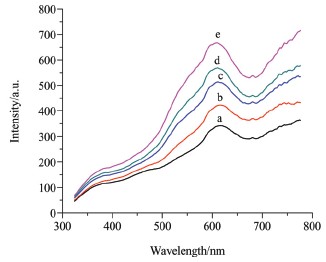[1] Sanvicens, N.; Marco, M. P.
Trends Biotechnol.
2008,
26, 425.

[2] Tongprasert, F.; Wanapirak, C.; Tongsong, T.
Prenatal Diagn.
2011,
31, 430.

[3] Cole, L. A.; Butler, S. A.; Khanlian, S. A.; Giddings, A.; Muller, C. Y.; Seckl, M. J.; Kohorn, E. I.
Gynecol.
Oncol.
2006,
102, 151.

[4] Yang, H.-C.; Yuan, R.; Chai, Y.-Q.; Zhuo, Y.
Colloids Surf.,
B 2011,
82, 463.

[5] Chai, R.; Yuan, R.; Chai, Y.-Q.; Ou, C.-F.; Cao, S.-R.; Li, X.-L.
Talanta 2008,
74, 1330.

[6] Lim, T. K.; Matsunaga, T.
Biosens.
Bioelectron.
2001,
16, 1063.

[7] Yang, G.-M.; Yang, X.-Y.; Yang, C.-Y.; Yang, Y.-H.
Colloids Surf.,
A 2011,
389, 195.

[8] Mao, L.; Yuan, R.; Chai, Y.-Q.; Zhuo, Y.; Yang, X.
Sens.
Actuators B 2010,
149, 226.
[9] Li, R.; Wu, D.; Li, H.; Xu, C.-X.; Wang, H.; Zhao, Y.-F.; Cai, Y.-Y.; Wei, Q.; Du, B.
Anal.
Biochem.
2011,
414, 196.
[10] Kim, H. S.; Pyun, J. C.
Procedia Chem. 2009,
1, 1043.

[11] Luo, L.; Zhang, Z.-J.; Hou, L.-Y.; Wang, J.-L.; Tian, W.
Talanta 2007,
72, 1293.

[12] Yan, X.; Huang, Z.-B.; He, M.; Liao, X.-M.; Zhang, C.-Q.; Yin, G.-F.; Gu, J.-W.
Colloids Surf.,
B 2012,
89, 86.

[13] Nakamura, N.; Lim, T. K.; Jeong, J. M.; Matsunaga, T.
Anal.
Chim.
Acta 2001,
439, 125.
[14] Hudelist, G.; Wuelfing, P.; Czerwenka, K.; Kn
öfler, M.; Haider, S.; Fink-Retter, A.; Gschwantler-Kaulich, D.; Pfeiler, G.; Kubista, E.; Singer, C. F.
J.
Cancer Res.
Clin.
Oncol.
2009,
135, 191.
[15] Jiang, Z.-L.; Zou, M.-J.; Liang, A.-H.
Clin.
Chim.
Acta 2008,
387, 24.
[16] Liang, A.-H.; Zou, M.-J.; Jiang, Z.-L.
Talanta 2008,
75, 1214.

[17] Nakamura, K.; Satomura, S.; Matsuura, S.
Anal.
Chem.
1993,
65, 613.
[18] Lv, M.-X.; Zhang, J.; Shen, Q.-Y.; Chen, K.-M.; Feng, G.-Y.
Chin. J. Biomed. Eng. 1992,
11, 174. (吕鸣详, 张杰, 申群英, 陈昆明, 冯光易, 中国生物医学工程学报,
1992,
11, 174.)
[19] Robinson, G. A.; Hill, H. A.; Philo, R. D.; Gear, J. M.; Rattle, S. J.; Forrest, G. C.
Clin.
Chem.
1985,
31, 1449.
[20] Guo, X.-Y.; Guan, Y.-P.; Yang, B.; Wang, Y.-N.; Lan, H.-L.; Yang, Z.-H.; Lu, Z.-H.
Int.
J.
Mol.
Sci.
2006,
7, 274.
[21] Vaitukatitis, J. L.; Braunstein, G. D.; Ross, G. T.
Am.
J.
Obstet.
Gynecol.
1972,
113, 751.
[22] Tung, N. H.; Chikae, M.; Ukita, Y.; Viet, P. H.; Takamura, Y.
Anal.
Chem.
2012,
84, 1210.
[23] Liang, A.-H.; Huang, Y.-J.; Jiang, Z.-L.
Clin.
Chim.
Acta 2007,
383, 73.
[24] Lin, S.-M.; Fan, Y.-Y.; Jiang, Z.-L.; Wen, G.-Q.; Liu, Q.-Y.; Liang, A.-H.
Acta Chim.
Sinica 2010,
68, 339. (凌绍明, 范燕燕, 蒋治良, 温桂清, 刘庆业, 梁爱惠, 化学学报,
2010,
68, 339.)
[25] Jiang, Z.-L.; Sun, S.-J.; Liang, A.-H.; Huang, W.-X.; Qin, A.-M.
Clin.
Chem.
2006,
52, 1389.
[26] Li, J.-F.; Jiang, Z.-L.; Deng, A.-P.
Chin.
J.
Chem.
2008,
26, 2297.
[27] Jiang, Z.-L.; Fan, Y.-Y.; Liang, A.-H.; Wen, G.-Q.; Liu, Q.-Y.; Li, T.-S.
Plasmonics 2010,
5, 375.

[28] Jiang, C.-N.; Liang, A.-H.; Jiang, Z.-L.
Acta Chim.
Sinica 2011,
69, 714. (蒋彩娜, 梁爱惠, 蒋治良, 化学学报
, 2011,
69, 714.)
[29] Zhang, Y.; Liang, A.-H.; Zhou, L.-P.; Qin, H.-M.; Ouyang, H.-X.; Wang, P.-F.; Jiang, Z.-L.
Acta Chim.
Sinica 2011,
69, 2153. (张轶, 梁爱惠, 周莲平, 覃惠敏, 欧阳辉祥, 王鹏飞, 蒋治良, 化学学报,
2011,
69, 2153.)
[30] Jiang, Z.-L.; Huang, Y.-J.; Liang, A.-H.; Pan, H.-C.; Liu, Q.-Y.
Biosens.
Bioelectron.
2009,
24, 1674. Jiang, Z.-L.; Liao, X.-J.; Deng, A.-P.; Liang, A.-H.; Li, J.-S.; Pan, H.-C.; Li, J.-F.; Wang, S.-M.; Huang, Y.-J.
Anal.
Chem.
2008,
80, 8681.














